Reward-Finder CS 175: Project in AI (in Minecraft)

Video
Project Summary
Solve an intricate maze with traps, lava, etc. Optimize by trying to improve the time the agent solves the maze or by finding the most optimal path. The input of the project would require a section of the map the agent would traverse. Output would be the most optimal path discovered by the agent. Lastly, we assume that every block is unknown and the agent must discover each path. Direct applications of this project would allow users to optimally beat multiple video games. At a high level, reinforcement learning discovered from this project can determine the ideal behavior within the manufacturing, delivery, and finance industries.
Different from what we proposed before, we added a new Level 0 to discover the relation between reward values and agent’s action.
Moreover, We also discarded our level 5(which include a zombie) since we found it was not necessary to add a zombie. The zombie does not affact what we want to study in this project. Instead, we made a larger and more complex map for level 4. Now, the agent can either Move 1 steps or Jump 2 steps. In this kind of map, the traditional shorest path algorithm wouldn’t work because of the complexity of the map and the number of actions. That is why we implemented reinforcement learning(eg. the Q-learning algorithm) in this project.
Here is a brief description of our test environment:
Level 0: Flat terrain, with edge boundary and hazards, two agents, agent1 must Jump to find the most optimal path (Actions: Walk, Jump)
Level 1: Flat terrain, with edge boundary (Actions: Walk, Jump)
Level 2: Flat terrain, with edge boundary and hazards in the middle of the map (Actions: Walk, Jump)
Level 3: 3D terrain, hills, hazards, blocks (Actions: Walk, Jump)
Level 4: 3D terrain, hills, hazards, blocks, a larger and more complex map (Actions: Walk, Jump)
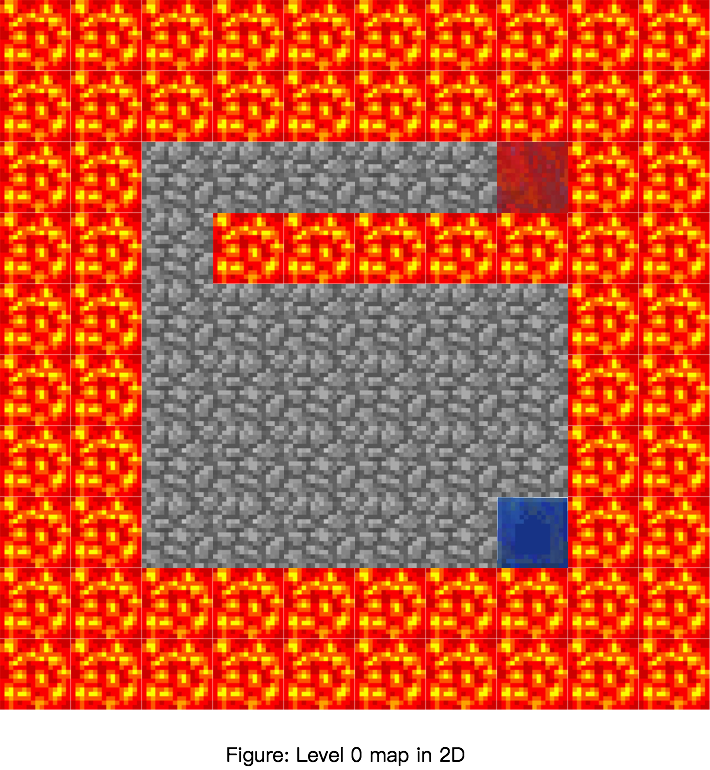
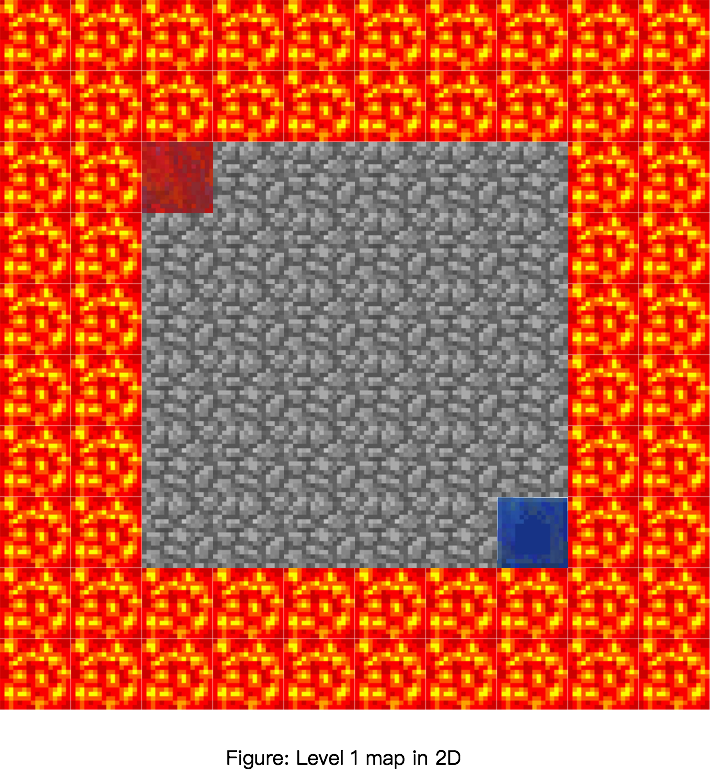
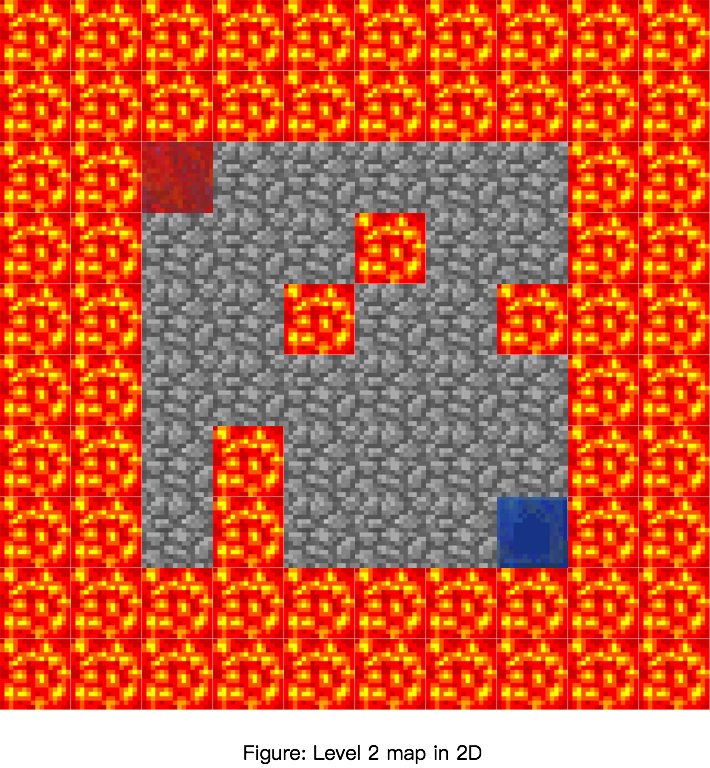
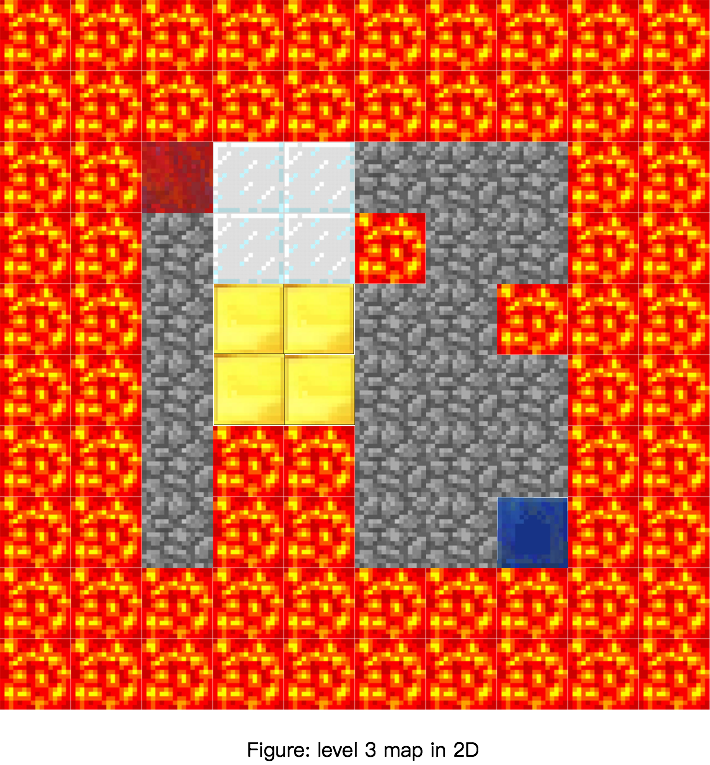

Approaches
For final report, our approach used the Q-Learning algorithm. Here is the equation of Q-Learning algorithm and our parameter set-up.
The Q-Learning equation:

self.epsilon = 0.01 # chance of taking a random action instead of the best
self.alpha = 0.1 # learning rate
self.gamma = 1.0 # discount rate
# Set of actions
self.actions = ["movewest 1", "moveeast 1", "movenorth 1", "movesouth 1", "tpn", "tps", "tpe", "tpw"]
# Additional action costs to take into account (Each action costs 1 by default).
# Action cost = 1 + self.action_cost[i]
#agent 1
self.action_cost = [0, 0, 0, 0, 9, 9, 9, 9]
#agent 2
self.action_cost = [0, 0, 0, 0, 300, 300, 300, 300]
#Initial Q Values (this snippet is used everytime agent discovers a new area in the map)
if not self.q_table.has_key(current_s):
self.q_table[current_s] = [0, 0, 0, 0, -2, -2, -2, -2]
Learning Rate:
Alpha represents the learning rate. It is value between 0 and 1 ( 0 < a < 1). It indicates how much the utility values will be updated every time the agent takes an action. alpha = 0 means the agent will not learn anything. alpha = 1 means the agent will not consider any feature states (the agent only consider most recent information). In stochastic environment, alpha is preferable closer to 0 than 1. In our approach, we decide alpha value to be 0.1
Discount Factor:
Gamma is the discount factor. It determines the importance of future information. Gamma closer to 0 will encourages the agent to seek out rewards sooner rather than later. It makes the agent assign a smaller reward to the feature action. Gamma closer to 1 will makes the agent seek for high reward in the feature. This value usually closer to 1. We set gamma value to 1 in our approach
Random Action: Epsilon is the possibility of taking a random action instead of the best one.
Immediate Reward Value: r is the immediate reward value.
Max Q Value: The action has the highest utility value in next state will become the new Q value of that states.
The reason we chose this parameter set:
We changed these parameter to see the effects on agent’s performance. We tested the agent’s performance with different parameter sets(total: 80 combinations). The test was based on level 1(we were planning to get data from level2,3,4 also, however, it took a long time to get all the data. Therefore, we only got data from level 1).
elist = [0.01,0.1,0.3,0.5] #list of epsilon, 4 values
alist = [0.05,0.1,0.5,0.75,1] #list of alpha, 5 values
glist = [0.25,0.5,0.75,1] #list of gamma, 4 values
For each of the combinations, we plotted a graph. We find out alpha = 0.1, gamma = 1.0 and epsilon = 0.01 fits all of our maps. A large alpha value(0.75) and gamma value(0.75) will let the agent find the best reward sooner in a simple map(level 1) but it will not work in a very complex map(level 4).
Initial Q Values:
We decided to give each state 8 initial Q Values where the first 4 values are 0 and the last 4 are -2. These values were set to make the agent prefer walking over jumping initially until walking’s Q value drops to -2. This was only used for levels 1, 2, 3.
Note: Notice how each action costs 1 by default. We decided to create an action_cost array to add additional cost to specific actions. A ‘jump’ has an additional cost of 9 on top of the default cost of 1 whereas a ‘move’ has no added cost.
Advantages of Q-Learning:
- Allows the agent to perform exploration and take new action with unknown consequences.
- Allows the agent to potentially retrieve a more accurate model of the environment.
- Discover higher-reward states than the ones already found.
Disadvantages of Q-Learning:
- While performing exploration, you may not necessarily reach a higher reward state (something bad could happen).
- Exploration takes multiple trials and could potentially drain your available computational resources.
- Too high of an epsilon value(random action) may prevent you from discovering a truly optimal strategy.
Test Environments/Maps:
Currently, we have five maps, level 0 is based on level 1, level 2 is is based on level 1, level 3 is based on level 3, level 4 based on level 3. The figures show the grid layouts in two-dimensional. The figures specify the start and end blocks. Also,the figures show the terrian of mazes(the floor of the maze is cobblestone, block is built by glass_blocks, hill is built by cobblestone_blocks). The number in each grids represent the (x,z) value and each grids has an altitude value which is y.
Level 0:
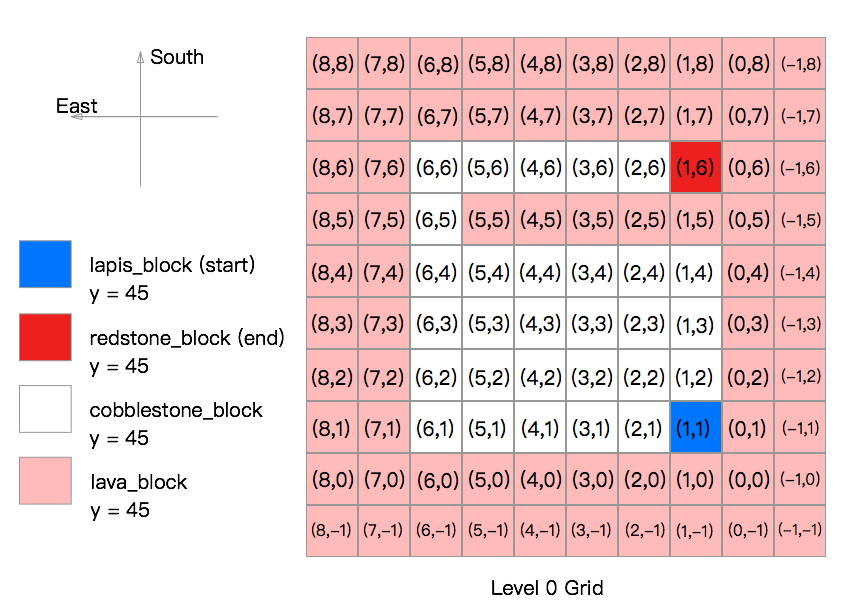
- The level 0 map is a flat terrain with lava on eages. There is a lava river blocks agent way to reach the goal state. It is a 8x8x1(LxWxH) grid. There are two agents in this level, agent1 must Jump to find the most optimal path. This level was used to show how changing the cost of jumping forces the agent to choose one path over the other. The first optimal path to the goal involves jumping over the lava to reach the goal block, whereas the second optimal path only includes walking. In level 1, there are 64 states and 8 actions.
- Reward for each actions for Agent 1:
For each action the agent makes, there is a reward value of -1 for each move, -10 for each jump, -100 for reaching the lava block, +300 for reaching the redstone_block(goal state).
- Reward for each actions for Agent 2:
For each action the agent makes, there is a reward value of -1 for each move, -301 for each jump, -100 for reaching the lava block, +300 for reaching the redstone_block(goal state)
Level 1:

- The level 1 map is a flat terrain with lava on eages. It is a 8x8x1(LxWxH) grid. The agent start at the lapis_block and try to reach the redstone_block. The agent can either walk or jump. In level 1, there are 64 states and 8 actions.
- Reward for each actions:
For each action the agent makes, there is a reward value of -1 for each move, -10 for each jump, -100 for reaching the lava block, +100 for reaching the redstone_block(goal state)
Level 2:
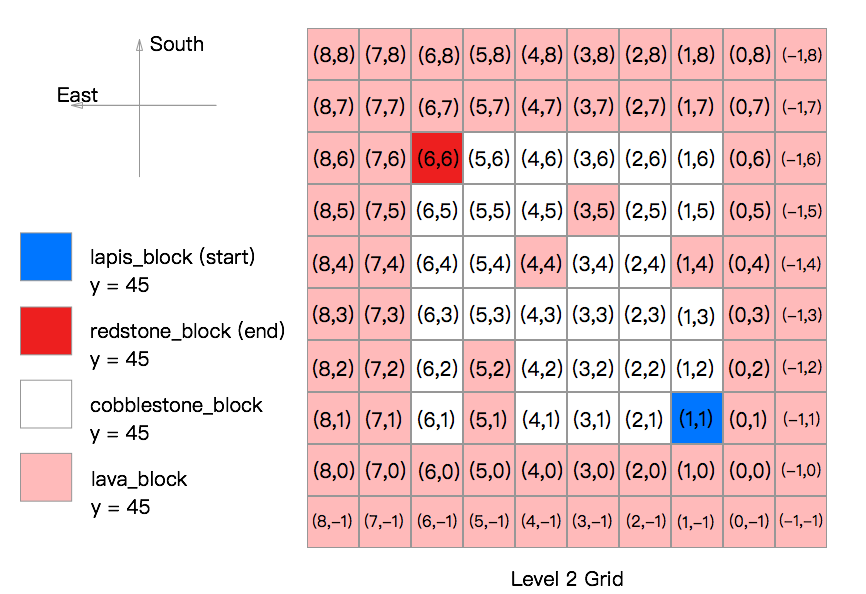
- The level 1 map is built based on Level 1 map. 5 cobble stone blocks in the middle of map were replaced by 5 lava blocks.It is a 8x8x1(LxWxH) grid. The agent start at the lapis_block and try to reach the redstone_block. The agent can either walk or jump. In level 2, there are 64 states and 8 actions.
- Reward for each actions:
For each action the agent makes, there is a reward value of -1 for each move, -10 for each jump, -100 for reaching the lava block, +100 for reaching the redstone_block(goal state)
Level 3:
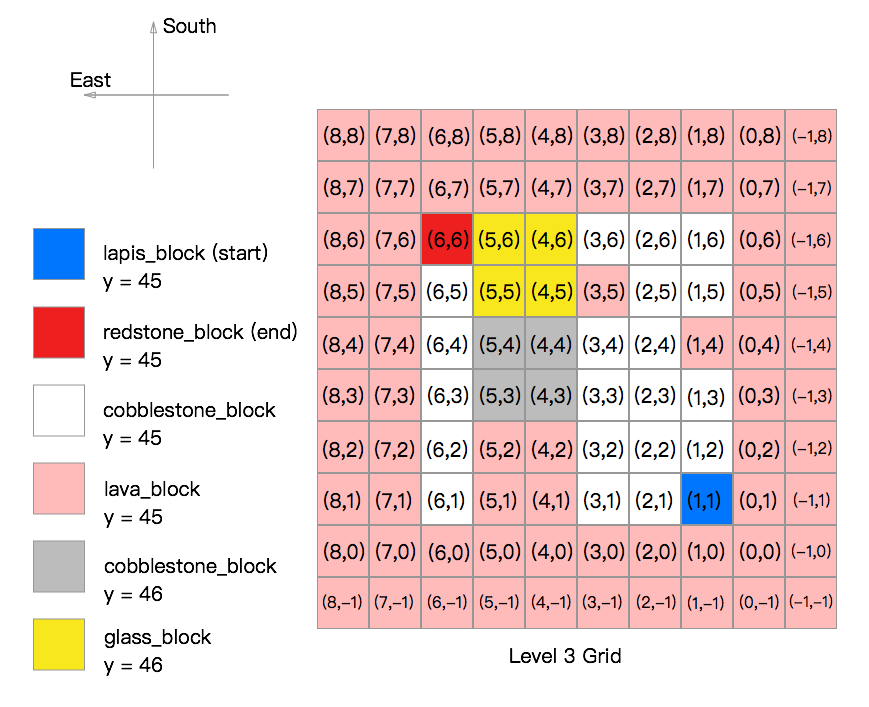
- Level 3 map was built based on level 2 map. A 2x2x2(LxWxH) glass block and a 2x2x1(LxWxH) cobble stone hill. Agent can jump over the cobble stone block(gold) but cannot jump over the glass block. The agent start at the lapis_block and try to reach the redstone_block. The agent can either walk or jump. In level 3, there are 64 states and 8 actions.
- Reward for each actions:
For each action the agent makes, there is a reward value of -1 for each move, -10 for each jump, -100 for reaching the lava block, +100 for reaching the redstone_block(goal state)
Level 4:
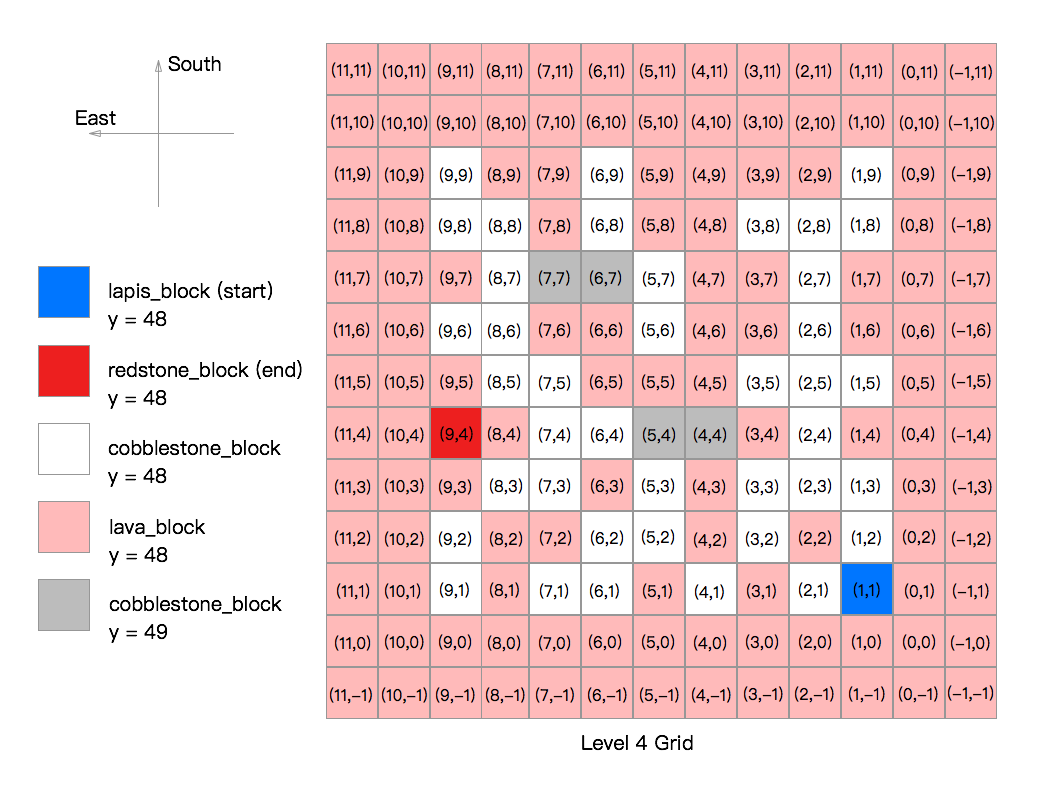
- The Level 4 map has the same concept as level 3 map but larger and more complex. It is a 11x11x3(LxWxH) grid. The first optimal path to the goal involves jumping over the lava to reach the goal block. This map can evaluate the agent’s ability to solve a complex problem. In level 3, there are 121 states and 8 actions.
- Reward for each actions: For each action the agent makes, there is a reward value of -1 for each move, -10 for each jump, -100 for reaching the lava block, +300 for reaching the redstone_block(goal state)
Evaluation
For qualitative evaluation, we evaluate our project by checking how well the agent can solve all 4 level mazes. We observe the agent when it is solving the maze to verify it works correctly. Also, we can check our agent by using the Cumulative Rewards Table.
For quantitative evaluation, we plotted the reward values in a graph to see whether or not the reward found by the agent eventually converges near the optimal solution. We plotted the optimal solution as a dashed red line and the rewards found by the agent as a blue solid line.
- Level 0:
(In this level the reward of the goal block is 300)
Agent 1 (-10 reward for each jump): The optimal path of level 1(agent1) is (1,1) moves-> (1,2) moves-> (1,3) moves-> (1,4) jumps-> (1,6). It takes 4 actions, 3 moves and 1 jump. Therefore, the best reward we can get is 300 - 3 - 10 = 287. The evaluation graph shows how the agent successfully finds the solution with the highest reward. Notice how towards the end the value converges to 287.
Agent 2 (-301 reward for each jump): One of the optimal path of level 0(agent2) is (1,1) moves-> (2,1) moves-> (3,1) moves-> (4,1) moves-> (5,1) moves-> (6,1) moves-> (6,2) moves-> (6,3) moves-> (6,4) moves-> (6,5) moves-> (6,6) moves-> (5,6) moves-> (4,6) moves-> (3,6) moves-> (2,6) moves-> (1,6). It takes 15 actions. Therefore, the best reward we can get is 285. The evaluation graph shows how the agent successfully finds the solution with the highest reward. Notice how towards the end the value converges to 285.
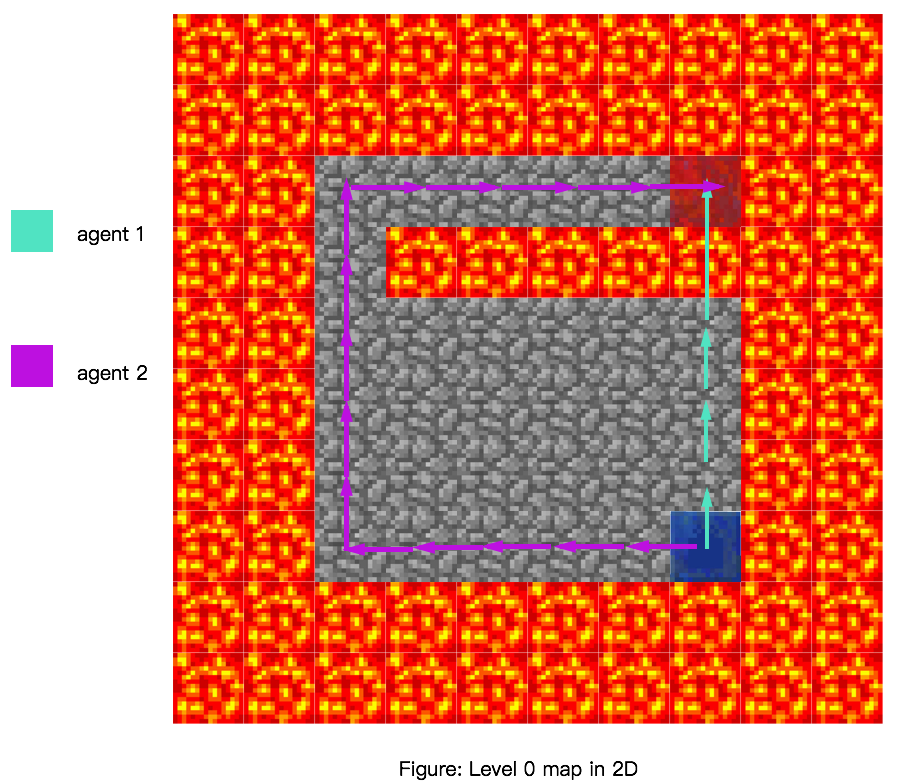

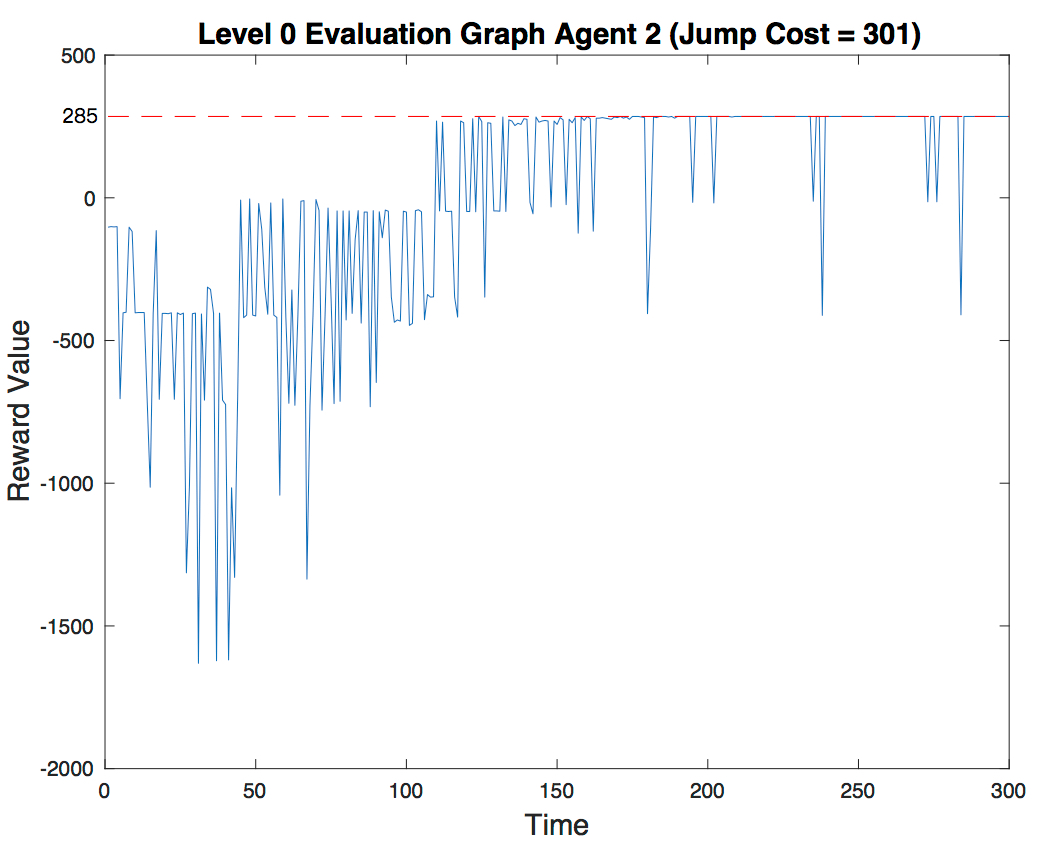
- Level 1:
One of the optimal path of level 1 is (1,1) moves-> (1,2) moves-> (1,3) moves-> (1,4) moves-> (1,5) moves-> (1,6) moves-> (2,6) moves-> (3,6) moves-> (4,6) moves-> (5,6) moves-> (6,6). It takes 10 actions. Therefore, the best reward we can get is 90. The evaluation graph shows how the agent successfully finds the solution with the highest reward. Notice how towards the end the value converges to 90.
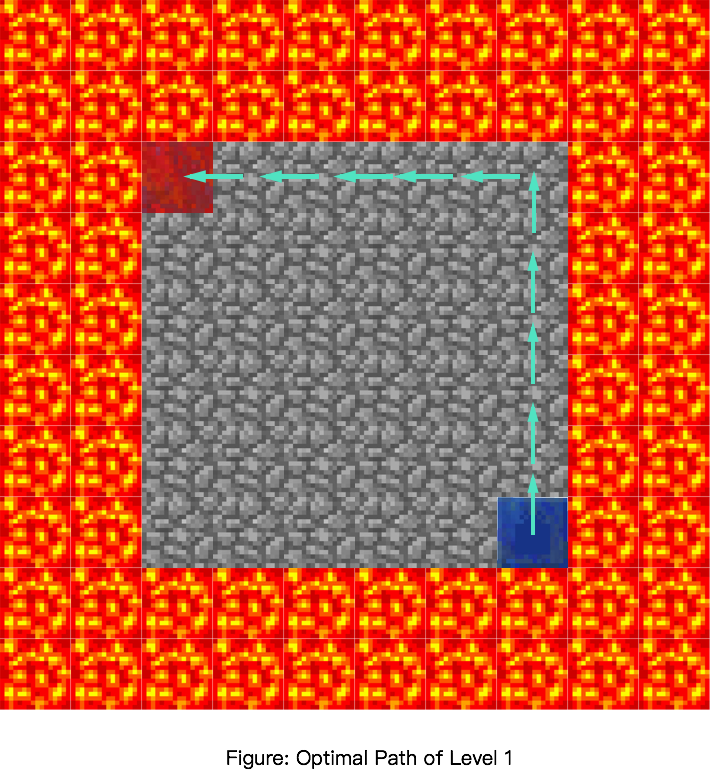
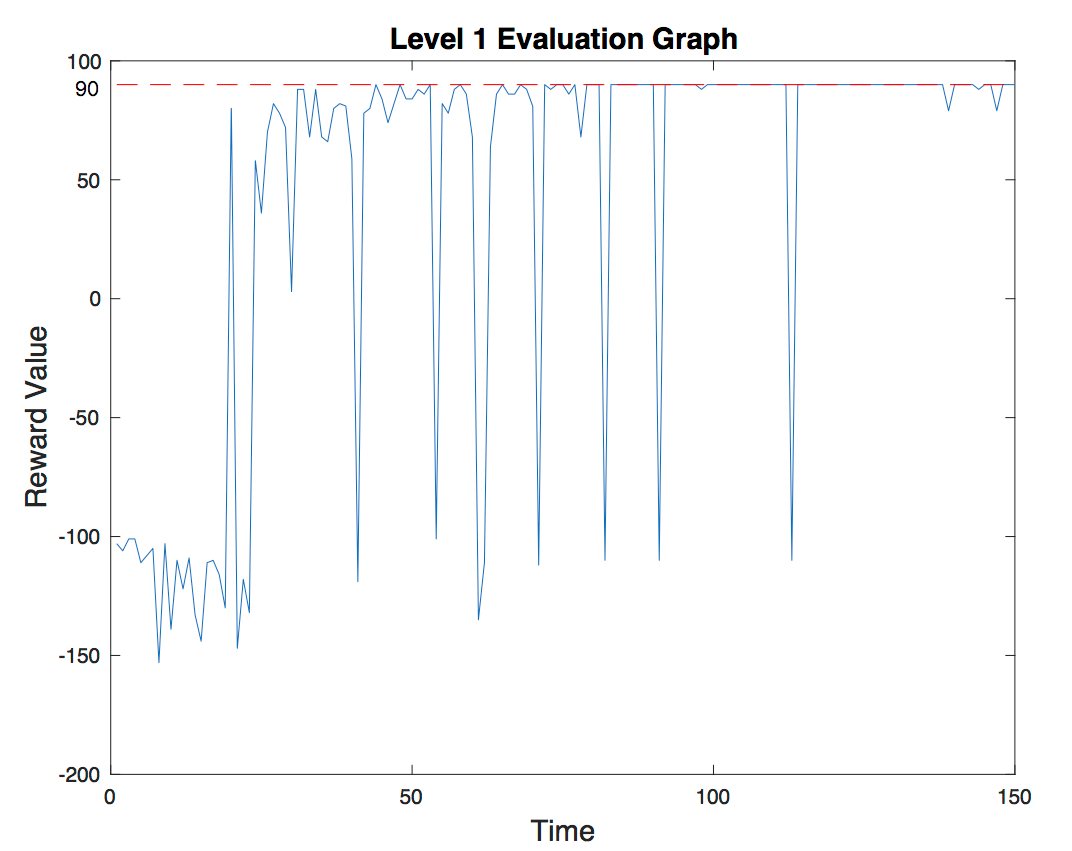
- Level 2:
One of the optimal path of level 2 is (1,1) moves-> (2,1) moves-> (2,2) moves-> (2,3) moves-> (3,3) moves-> (4,3) moves-> (5,3) moves-> (5,4) moves-> (5,5) moves-> (5,6) moves-> (6,6). It also takes 10 moves. Therefore, the best reward we can get is 90. The agent successfully finds the solution with the highest reward in level 2.Notice how towards the end the value converges to 90.

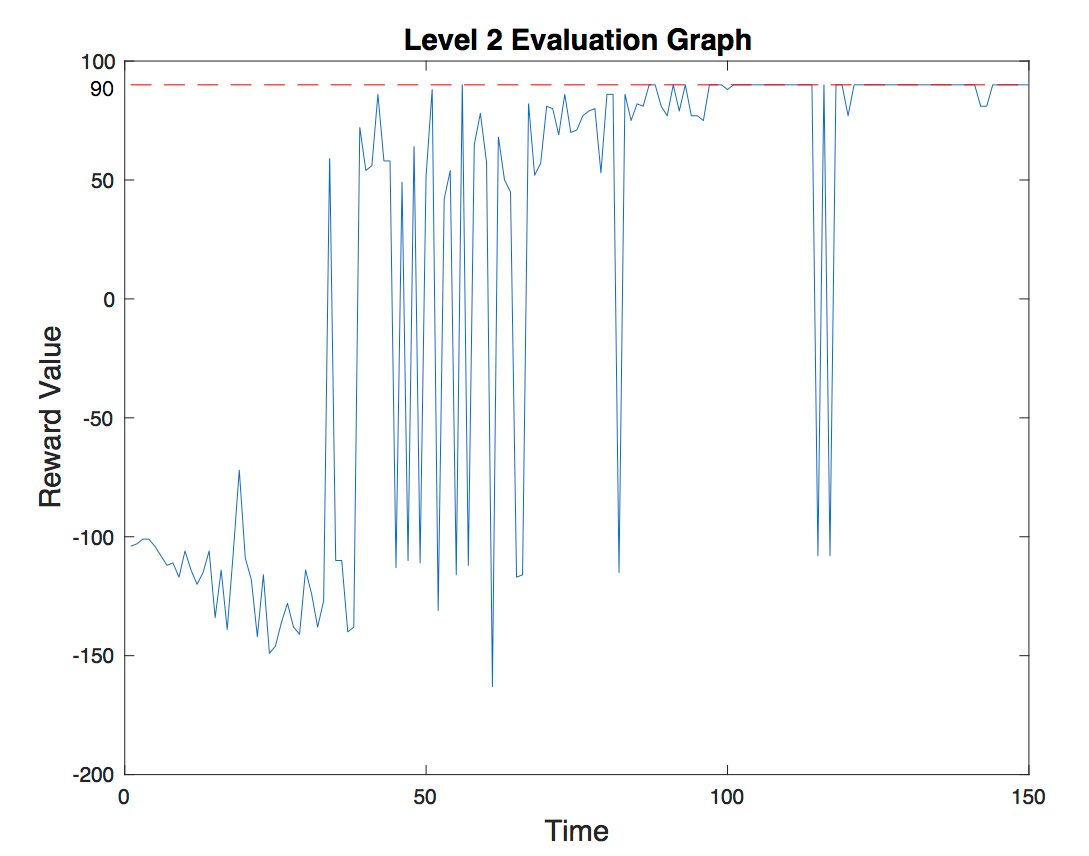
- Level 3:
One of the optimal path of level 3 is (1,1) moves-> (2,1) moves-> (2,2) moves-> (2,3) moves-> (3,3) moves-> (3,4) jumps-> (4,4) moves-> (5,4) moves-> (6,4) moves-> (6,5) moves-> (6,6). It takes 10 actions. However, from (3,4) to (4,4) the agent takes the action “JUMP” witch takes 10 rewards. Therefore, the best reward is 100 - 10 - 9 = 81. The evaluation graph shows how the agent successfully finds the solution with the highest reward. Notice how towards the end the value converges to 81.
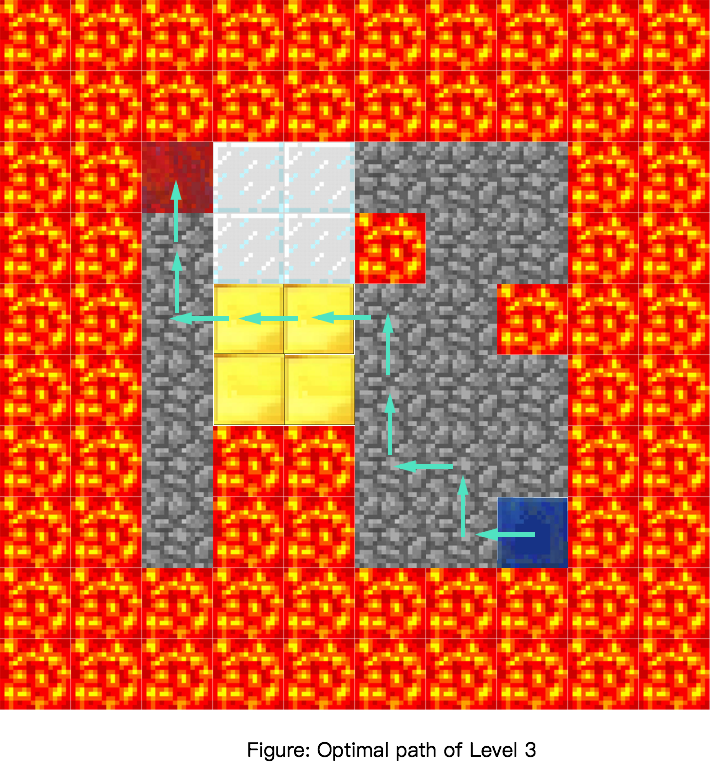
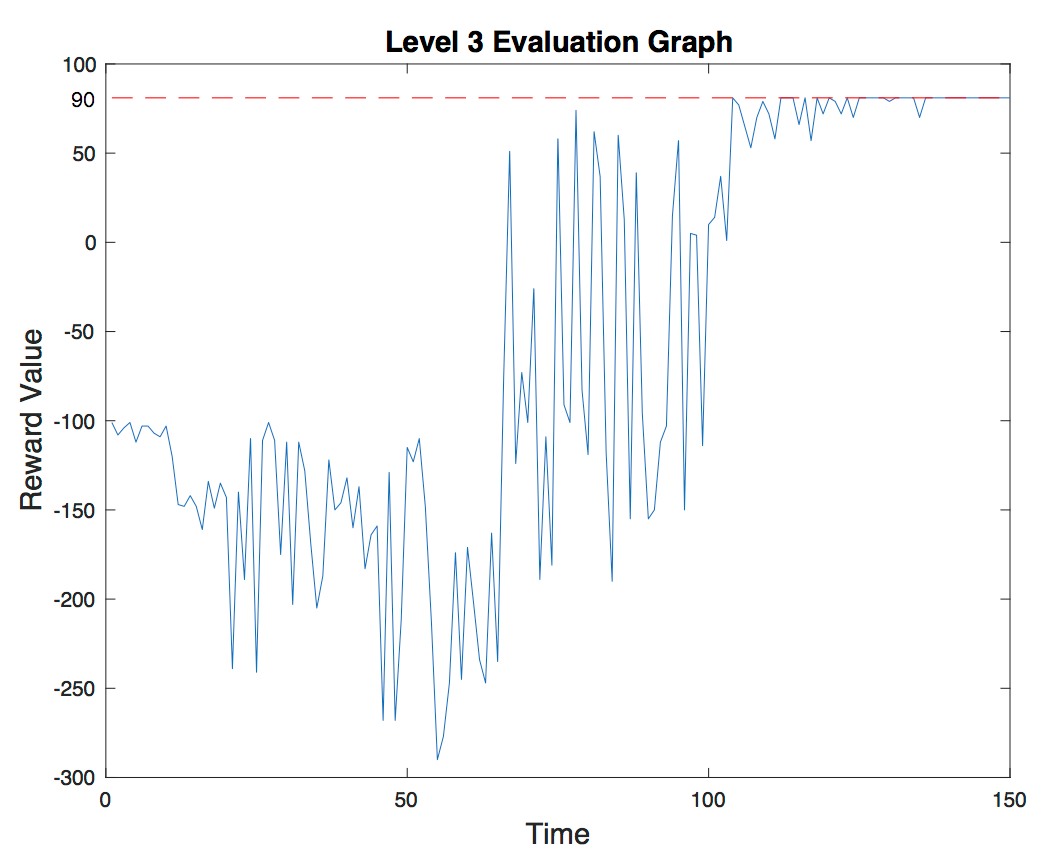
- Level 4:
(In this level the reward of the goal block is 300)
The optimal path of level 3 is (1,1) moves-> (1,2) moves-> (1,3) moves-> (2,3) moves-> (2,4) jumps-> (4,4) moves-> (5,4) moves-> (6,4) moves-> (7,4) jumps-> (9,4). It takes 9 actions(7 moves and 2 jumps. Therefore, the best reward is 300 - 10*2 - 7 = 273. The evaluation graph shows how the agent successfully finds the solution with the highest reward. Notice how towards the end the value converges to 273.

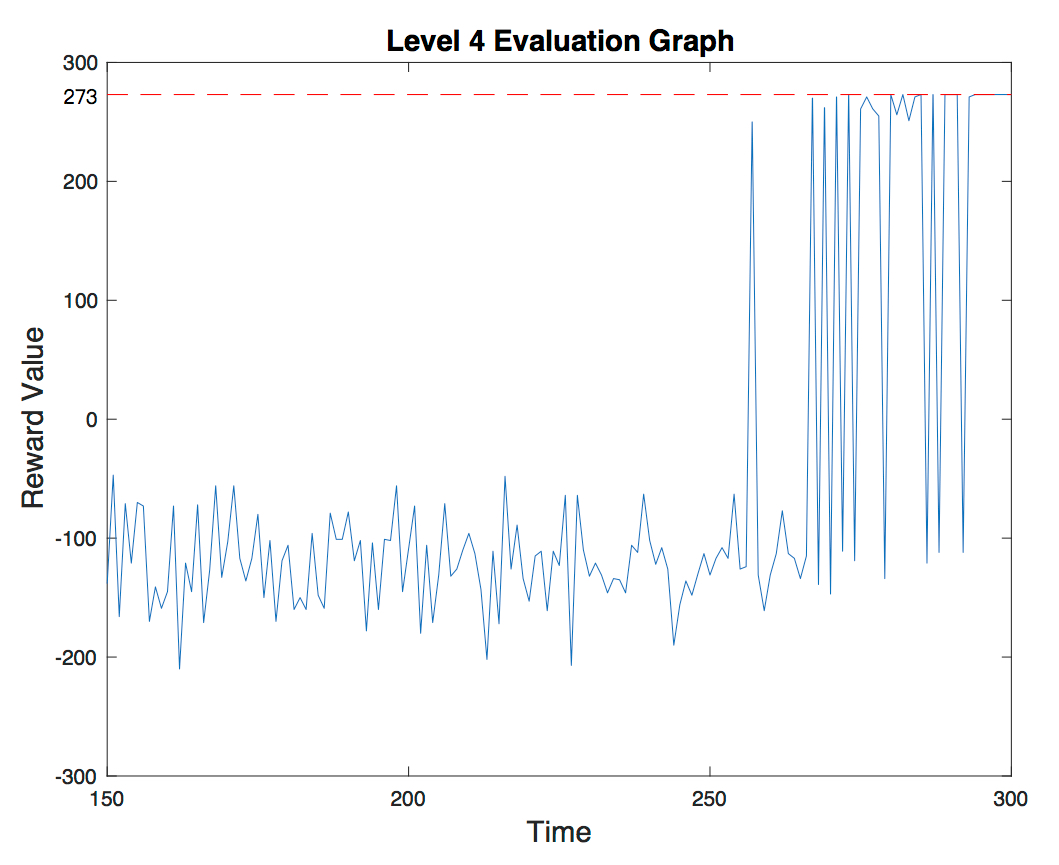
- In addition to plotting graphs, we decided to use a second method for quantitative evaluation. We evaluated our project by checking how long it takes the agent to solve each mazes. That is, we wanted the agent to slove the maze as quick as it can. We used the Cumulative Rewards Table to check how many runs it takes before getting the best reward. The best result we got so far is, the agent 1 needs 48 runs in level 0, the agnet 2 needs 135 runs in level 0, the agent 1 needs 44 runs in level 1, 56 runs in level 2, 104 runs in level 3 and 251 runs in level 4. We improved this by changing our reward function and Q-Learning parameters.

References
- Reinforcement Learning 3 - Q Learning: https://www.youtube.com/watch?v=1XRahNzA5bE&t=309s/
- Wikipedia on Q Learning: https://en.wikipedia.org/wiki/Q-learning
- The “Cliff Walking” example using Q-learning: https://www.youtube.com/watch?v=9XRL6d-yxp4
- Tutorial 6 From Malmo References
Images
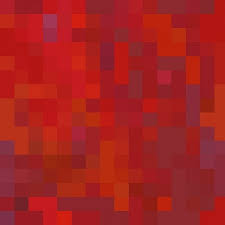 Redstone_block.jpeg: roblox
Redstone_block.jpeg: roblox Lapis_block.jpeg: roblox
Lapis_block.jpeg: roblox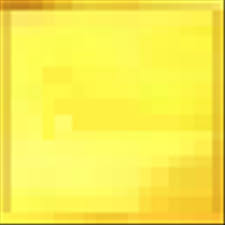 Gold_block.jpeg: roblox
Gold_block.jpeg: roblox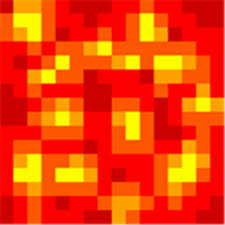 Lava_block.jpeg: roblox
Lava_block.jpeg: roblox Glass_block.png: Minecraft Modding
Glass_block.png: Minecraft Modding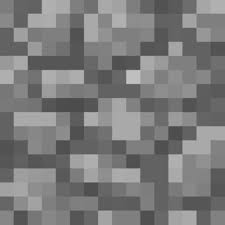 Cobblestone_block.jpeg: roblox
Cobblestone_block.jpeg: roblox agent.jpeg: Hannahevans Gallery
agent.jpeg: Hannahevans Gallery